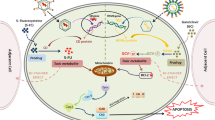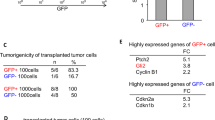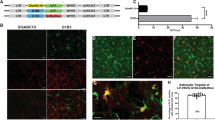Abstract
Tumor-tropic neural stem cells (NSCs) can be used in the Trojan horse approach as cellular vehicles for targeted delivery of therapeutic agents to distant tumor sites. To realize this cancer therapy potential, it is important to have a renewable source to generate large quantities of uniform human NSCs. Here, we reported that NSCs derived from HES1 human embryonic stem cell line were capable of migrating into intracranial glioma xenografts after systemic injection or after intracranial injection at a site distant from the tumor. To test whether the HES1-derived NSCs can be used for cancer gene therapy, we used a baculoviral vector to introduce the herpes simplex virus thymidine kinase suicide gene into the cells and demonstrated that baculovirus-mediated transgene expression may last for at least 3 weeks in NSCs. After being injected into the cerebral hemisphere opposite the tumor site and in the presence of ganciclovir, NSCs expressing the suicide gene were able to inhibit the growth of human glioma xenografts and prolong survival of tumor-bearing mice. Our findings suggest that human embryonic stem cells could potentially serve as a clinically viable source for production of cellular vehicles suitable for targeted anticancer gene therapy.
This is a preview of subscription content, access via your institution
Access options
Subscribe to this journal
Receive 12 print issues and online access
$259.00 per year
only $21.58 per issue
Buy this article
- Purchase on Springer Link
- Instant access to full article PDF
Prices may be subject to local taxes which are calculated during checkout







Similar content being viewed by others
References
Flax JD, Aurora S, Yang C, Simonin C, Wills AM, Billinghurst LL et al. Engraftable human neural stem cells respond to developmental cues, replace neurons, and express foreign genes. Nat Biotechnol 1998; 16: 1033–1039.
Aboody KS, Brown A, Rainov NG, Bower KA, Liu S, Yang W et al. Neural stem cells display extensive tropism for pathology in adult brain: evidence from intracranial gliomas. Proc Natl Acad Sci USA 2000; 97: 12846–12851.
Benedetti S, Pirola B, Pollo B, Magrassi L, Bruzzone MG, Rigamonti D et al. Gene therapy of experimental brain tumors using neural progenitor cells. Nat Med 2000; 6: 447–450.
Ehtesham M, Kabos P, Gutierrez MA, Chung NH, Griffith TS, Black KL et al. Induction of glioblastoma apoptosis using neural stem cell-mediated delivery of tumor necrosis factor-related apoptosis-inducing ligand. Cancer Res 2002; 62: 7170–7174.
Brown AB, Yang W, Schmidt NO, Carroll R, Leishear KK, Rainov NG et al. Intravascular delivery of neural stem cell lines to target intracranial and extracranial tumors of neural and non-neural origin. Hum Gene Ther 2003; 14: 1777–1785.
Lee J, Elkahloun AG, Messina SA, Ferrari N, Xi D, Smith CL et al. Cellular and genetic characterization of human adult bone marrow-derived neural stem-like cells: a potential antiglioma cellular vector. Cancer Res 2003; 63: 8877–8889.
Staflin K, Honeth G, Kalliomaki S, Kjellman C, Edvardsen K, Lindvall M . Neural progenitor cell lines inhibit rat tumor growth in vivo. Cancer Res 2004; 64: 5347–5354.
Aboody KS, Bush RA, Garcia E, Metz MZ, Najbauer J, Justus KA et al. Development of a tumor-selective approach to treat metastatic cancer. PLoS One 2006; 1: e23.
Kim SK, Kim SU, Park IH, Bang JH, Aboody KS, Wang KC et al. Human neural stem cells target experimental intracranial medulloblastoma and deliver a therapeutic gene leading to tumor regression. Clin Cancer Res 2006; 12: 5550–5556.
Yuan X, Hu J, Belladonna ML, Black KL, Yu JS . Interleukin-23-expressing bone marrow-derived neural stem-like cells exhibit antitumor activity against intracranial glioma. Cancer Res 2006; 66: 2630–2638.
Dickson PV, Hamner JB, Burger RA, Garcia E, Ouma AA, Kim SU et al. Intravascular administration of tumor tropic neural progenitor cells permits targeted delivery of interferon-beta and restricts tumor growth in a murine model of disseminated neuroblastoma. J Pediatr Surg 2007; 42: 48–53.
Miletic H, Fischer Y, Litwak S, Giroglou T, Waerzeggers Y, Winkeler A et al. Bystander killing of malignant glioma by bone marrow-derived tumor-infiltrating progenitor cells expressing a suicide gene. Mol Ther 2007; 15: 1373–1381.
Shimato S, Natsume A, Takeuchi H, Wakabayashi T, Fujii M, Ito M et al. Human neural stem cells target and deliver therapeutic gene to experimental leptomeningeal medulloblastoma. Gene Therapy 2007; 14: 1132–1142.
Lorico A, Mercapide J, Solodushko V, Alexeyev M, Fodstad O, Rappa G . Primary neural stem/progenitor cells expressing endostatin or cytochrome P450 for gene therapy of glioblastoma. Cancer Gene Ther 2008; 15: 605–615.
Zhao Y, Wang S . Human NT2 neural precursor-derived tumor-infiltrating cells as delivery vehicles for treatment of glioblastoma. Hum Gene Ther 2010; 21: 683–694.
Hacein-Bey-Abina S, Von Kalle C, Schmidt M, McCormack MP, Wulffraat N, Leboulch P et al. LMO2-associated clonal T cell proliferation in two patients after gene therapy for SCID-X1. Science 2003; 302: 415–419.
Schroder AR, Shinn P, Chen H, Berry C, Ecker JR, Bushman F . HIV-1 integration in the human genome favors active genes and local hotspots. Cell 2002; 110: 521–529.
Liu H, Dow EC, Arora R, Kimata JT, Bull LM, Arduino RC et al. Integration of human immunodeficiency virus type 1 in untreated infection occurs preferentially within genes. J Virol 2006; 80: 7765–7768.
Wang S, Balasundaram G . Potential cancer gene therapy by baculoviral transduction. Curr Gene Ther 2010; 10: 214–225.
Kost TA, Condreay JP, Jarvis DL . Baculovirus as versatile vectors for protein expression in insect and mammalian cells. Nat Biotechnol 2005; 23: 567–575.
Hu YC . Baculoviral vectors for gene delivery: a review. Curr Gene Ther 2008; 8: 54–65.
Abe T, Matsuura Y . Host innate immune responses induced by baculovirus in mammals. Curr Gene Ther 2010; 10: 226–231.
Airenne KJ, Makkonen KE, Mahonen AJ, Yla-Herttuala S . In vivo application and tracking of baculovirus. Curr Gene Ther 2010; 10: 187–194.
Zeng J, Du J, Zhao Y, Palanisamy N, Wang S . Baculoviral vector-mediated transient and stable transgene expression in human embryonic stem cells. Stem Cells 2007; 25: 1055–1061.
Du J, Zeng J, Zhao Y, Boulaire J, Wang S . The combined use of viral transcriptional and post-transcriptional regulatory elements to improve baculovirus-mediated transient gene expression in human embryonic stem cells. J Biosci Bioeng 2010; 109: 1–8.
Ho YC, Lee HP, Hwang SM, Lo WH, Chen HC, Chung CK et al. Baculovirus transduction of human mesenchymal stem cell-derived progenitor cells: variation of transgene expression with cellular differentiation states. Gene Therapy 2006; 13: 1471–1479.
Bak XY, Yang J, Wang S . Baculovirus-transduced bone marrow mesenchymal stem cells for systemic cancer therapy. Cancer Gene Ther 2010; 17: 721–729.
Roy NS, Wang S, Jiang L, Kang J, Benraiss A, Harrison-Restelli C et al. In vitro neurogenesis by progenitor cells isolated from the adult human hippocampus. Nat Med 2000; 6: 271–277.
Keyoung HM, Roy NS, Benraiss A, Louissaint Jr A, Suzuki A, Hashimoto M et al. High-yield selection and extraction of two promoter-defined phenotypes of neural stem cells from the fetal human brain. Nat Biotechnol 2001; 19: 843–850.
Lee CM, Reddy EP . The v-myc oncogene. Oncogene 1999; 18: 2997–3003.
Reubinoff BE, Itsykson P, Turetsky T, Pera MF, Reinhartz E, Itzik A et al. Neural progenitors from human embryonic stem cells. Nat Biotechnol 2001; 19: 1134–1140.
Zhang SC, Wernig M, Duncan ID, Brustle O, Thomson JA . In vitro differentiation of transplantable neural precursors from human embryonic stem cells. Nat Biotechnol 2001; 19: 1129–1133.
Ben-Hur T, Idelson M, Khaner H, Pera M, Reinhartz E, Itzik A et al. Transplantation of human embryonic stem cell-derived neural progenitors improves behavioral deficit in Parkinsonian rats. Stem Cells 2004; 22: 1246–1255.
Tabar V, Panagiotakos G, Greenberg ED, Chan BK, Sadelain M, Gutin PH et al. Migration and differentiation of neural precursors derived from human embryonic stem cells in the rat brain. Nat Biotechnol 2005; 23: 601–606.
Ying QL, Stavridis M, Griffiths D, Li M, Smith A . Conversion of embryonic stem cells into neuroectodermal precursors in adherent monoculture. Nat Biotechnol 2003; 21: 183–186.
Conti L, Pollard SM, Gorba T, Reitano E, Toselli M, Biella G et al. Niche-independent symmetrical self-renewal of a mammalian tissue stem cell. PLoS Biol 2005; 3: e283.
Maisel M, Herr A, Milosevic J, Hermann A, Habisch HJ, Schwarz S et al. Transcription profiling of adult and fetal human neuroprogenitors identifies divergent paths to maintain the neuroprogenitor cell state. Stem Cells 2007; 25: 1231–1240.
Ehtesham M, Yuan X, Kabos P, Chung NH, Liu G, Akasaki Y et al. Glioma tropic neural stem cells consist of astrocytic precursors and their migratory capacity is mediated by CXCR4. Neoplasia 2004; 6: 287–293.
Jurvansuu J, Zhao Y, Leung DS, Boulaire J, Yu YH, Ahmed S et al. Transmembrane protein 18 enhances the tropism of neural stem cells for glioma cells. Cancer Res 2008; 68: 4614–4622.
Fukuyama K, Matsuzawa K, Hubbard SL, Dirks PB, Murakami M, Rutka JT . Analysis of glial fibrillary acidic protein gene methylation in human malignant gliomas. Anticancer Res 1996; 16: 1251–1257.
Condorelli DF, Nicoletti VG, Barresi V, Caruso A, Conticello S, de Vellis J et al. Tissue-specific DNA methylation patterns of the rat glial fibrillary acidic protein gene. J Neurosci Res 1994; 39: 694–707.
Zeng J, Du J, Lin J, Bak XY, Wu C, Wang S . High-efficiency transient transduction of human embryonic stem cell-derived neurons with baculoviral vectors. Mol Ther 2009; 17: 1585–1593.
Mesnil M, Yamasaki H . Bystander effect in herpes simplex virus-thymidine kinase/ganciclovir cancer gene therapy: role of gap-junctional intercellular communication. Cancer Res 2000; 60: 3989–3999.
Asklund T, Appelskog IB, Ammerpohl O, Langmoen IA, Dilber MS, Aints A et al. Gap junction-mediated bystander effect in primary cultures of human malignant gliomas with recombinant expression of the HSVtk gene. Exp Cell Res 2003; 284: 185–195.
Carpenter MK, Inokuma MS, Denham J, Mujtaba T, Chiu CP, Rao MS . Enrichment of neurons and neural precursors from human embryonic stem cells. Exp Neurol 2001; 172: 383–397.
Song J, Lee ST, Kang W, Park JE, Chu K, Lee SE et al. Human embryonic stem cell-derived neural precursor transplants attenuate apomorphine-induced rotational behavior in rats with unilateral quinolinic acid lesions. Neurosci Lett 2007; 423: 58–61.
Glaser T, Pollard SM, Smith A, Brustle O . Tripotential differentiation of adherently expandable neural stem (NS) cells. PLoS One 2007; 2: e298.
Hsieh J, Aimone JB, Kaspar BK, Kuwabara T, Nakashima K, Gage FH . IGF-I instructs multipotent adult neural progenitor cells to become oligodendrocytes. J Cell Biol 2004; 164: 111–122.
Ahmed AU, Rolle CE, Tyler MA, Han Y, Sengupta S, Wainwright DA et al. Bone marrow mesenchymal stem cells loaded with an oncolytic adenovirus suppress the anti-adenoviral immune response in the cotton rat model. Mol Ther 2010; 18: 1846–1856.
Sonabend AM, Ulasov IV, Tyler MA, Rivera AA, Mathis JM, Lesniak MS . Mesenchymal stem cells effectively deliver an oncolytic adenovirus to intracranial glioma. Stem Cells 2008; 26: 831–841.
Tyler MA, Ulasov IV, Sonabend AM, Nandi S, Han Y, Marler S et al. Neural stem cells target intracranial glioma to deliver an oncolytic adenovirus in vivo. Gene Therapy 2009; 16: 262–278.
Strauss R, Huser A, Ni S, Tuve S, Kiviat N, Sow PS et al. Baculovirus-based vaccination vectors allow for efficient induction of immune responses against plasmodium falciparum circumsporozoite protein. Mol Ther 2007; 15: 193–202.
Chuang CK, Wong TH, Hwang SM, Chang YH, Chen GY, Chiu YC et al. Baculovirus transduction of mesenchymal stem cells: in vitro responses and in vivo immune responses after cell transplantation. Mol Ther 2009; 17: 889–896.
Boulaire J, Balani P, Wang S . Transcriptional targeting to brain cells: Engineering cell type-specific promoter containing cassettes for enhanced transgene expression. Adv Drug Deliv Rev 2009; 61: 589–602.
Reekmans KP, Praet J, De Vocht N, Tambuyzer BR, Bergwerf I, Daans J et al. Clinical potential of intravenous neural stem cell delivery for treatment of neuro-inflammatory disease in mice? Cell Transplant 2010; e-pub ahead of print 19 November 2010, doi:10.3727/096368910X543411.
Acknowledgements
This work was supported by Institute of Bioengineering and Nanotechnology, Biomedical Research Council, Agency for Science, Technology and Research (A*STAR) in Singapore and a grant from National Medical Research Council in Singapore (NMRC/1203/2009).
Author information
Authors and Affiliations
Corresponding author
Ethics declarations
Competing interests
The authors declare no conflict of interest.
Additional information
The editor has retracted this article following an investigation by Agency for Science, Technology and Research (A*STAR), Institute of Bioengineering and Nanotechnology, Singapore, which found evidence of fabricated animal survival data presented in Figure 7C in the article to make the results statistically significant. D H Lam, J Yang, J Lin, C K Tham, W H Ng & S Wang agree to this retraction. Y Zhao has agreed to this retraction but not to the wording of this retraction notice.
About this article
Cite this article
Zhao, Y., Lam, D., Yang, J. et al. RETRACTED ARTICLE: Targeted suicide gene therapy for glioma using human embryonic stem cell-derived neural stem cells genetically modified by baculoviral vectors. Gene Ther 19, 189–200 (2012). https://doi.org/10.1038/gt.2011.82
Received:
Revised:
Accepted:
Published:
Issue Date:
DOI: https://doi.org/10.1038/gt.2011.82
Keywords
This article is cited by
-
Retraction Note: Targeted suicide gene therapy for glioma using human embryonic stem cell-derived neural stem cells genetically modified by baculoviral vectors
Gene Therapy (2020)
-
Tumoricidal effect of human olfactory ensheathing cell mediated suicide gene therapy in human glioblastoma cells
Molecular Biology Reports (2018)
-
Tumor-homing Stem Cell Therapy for Brain Cancer
Current Surgery Reports (2017)
-
Transgene expression in Penaeus monodon cells: evaluation of recombinant baculoviral vectors with shrimp specific hybrid promoters
Cytotechnology (2016)
-
A New Approach in Gene Therapy of Glioblastoma Multiforme: Human Olfactory Ensheathing Cells as a Novel Carrier for Suicide Gene Delivery
Molecular Neurobiology (2016)



